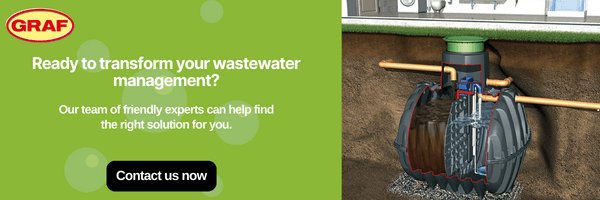The definition of sewage (wastewater) is both grey water which is water used in private houses from toilets, dishwashers, sinks, baths and showers and black water which is any water from toilets. This foul water can be treated by using either biological matter to break down the waste or physical treatment using aeration to treat the water.
If your property is not connected to the main sewer network, then you will need to install some form of sewage treatment system to process the wastewater into a form that can be safely drained into your local water course or can be discharged into a soakaway.
The solution to treating waste on site, which is becoming more common, is a sewage treatment plant. As the name suggests, a sewage treatment plant will treat the incoming waste from a property, to a point where it can safely re-enter the water cycle without causing damage to the local environment or eco-system.
A treatment plant, like a septic tank, has an inlet point and an outlet point and is made up of two chambers. The primary chamber, similar to a septic tank, will store the waste coming from the property before it moves to the secondary chamber. The secondary chamber is where the actual treatment happens. With a Graf UK system, for the treatment of the waste we use SBR technology, for example the One2Clean system. In the secondary chamber of the One2Clean system we introduce oxygen into the tank via an air diffuser which sits on the bottom of the wastewater tank. The diffuser helps to keep the bacteria (that naturally grows on the waste) alive by periodically giving the bacteria a supply of oxygen. The solids will then be retained in the wastewater tank, leaving the treated effluent to rise to the top of the water level before being discharged out of the tank into a soakaway or a flowing water course, e.g. stream or river, if permitted.
Sewage treatment plants are becoming more and more common throughout the UK because of the quality of the effluent that can be discharged from the plant, compared to old solutions like a septic tank or cesspool. The effluent quality from a sewage treatment plant is able to be discharged directly into a watercourse without causing any harm or damage to the local environment or eco-system. This is not the case for systems like a septic tank, because if poorly maintained a septic tank could cause raw sewage to be discharged into the ground or local watercourses.



